Comparative Financial Report of Vodafone Plc, BT Group, Telecom Plus
VerifiedAdded on 2023/06/15
|15
|3370
|319
Report
AI Summary
This report provides a comparative financial analysis of Vodafone Plc, BT Group, and Telecom Plus Plc, focusing on share price behavior, financial structure, and cost of capital. Share price behavior is evaluated through expected monthly returns, standard deviation, and correlation with the FTSE 100 index, forming portfolio combinations. Systematic risk is assessed using beta, and valuations are analyzed via the price-to-earnings ratio. The debt-to-equity ratio is used to analyze capital structure, and CAPM is employed to determine the cost of equity. The report concludes with a view on the expected future performances of the three stocks, offering advice for current shareholders on whether to buy or sell.

Comparative Financial Report on Vodafone Plc
Paraphrase This Document
Need a fresh take? Get an instant paraphrase of this document with our AI Paraphraser
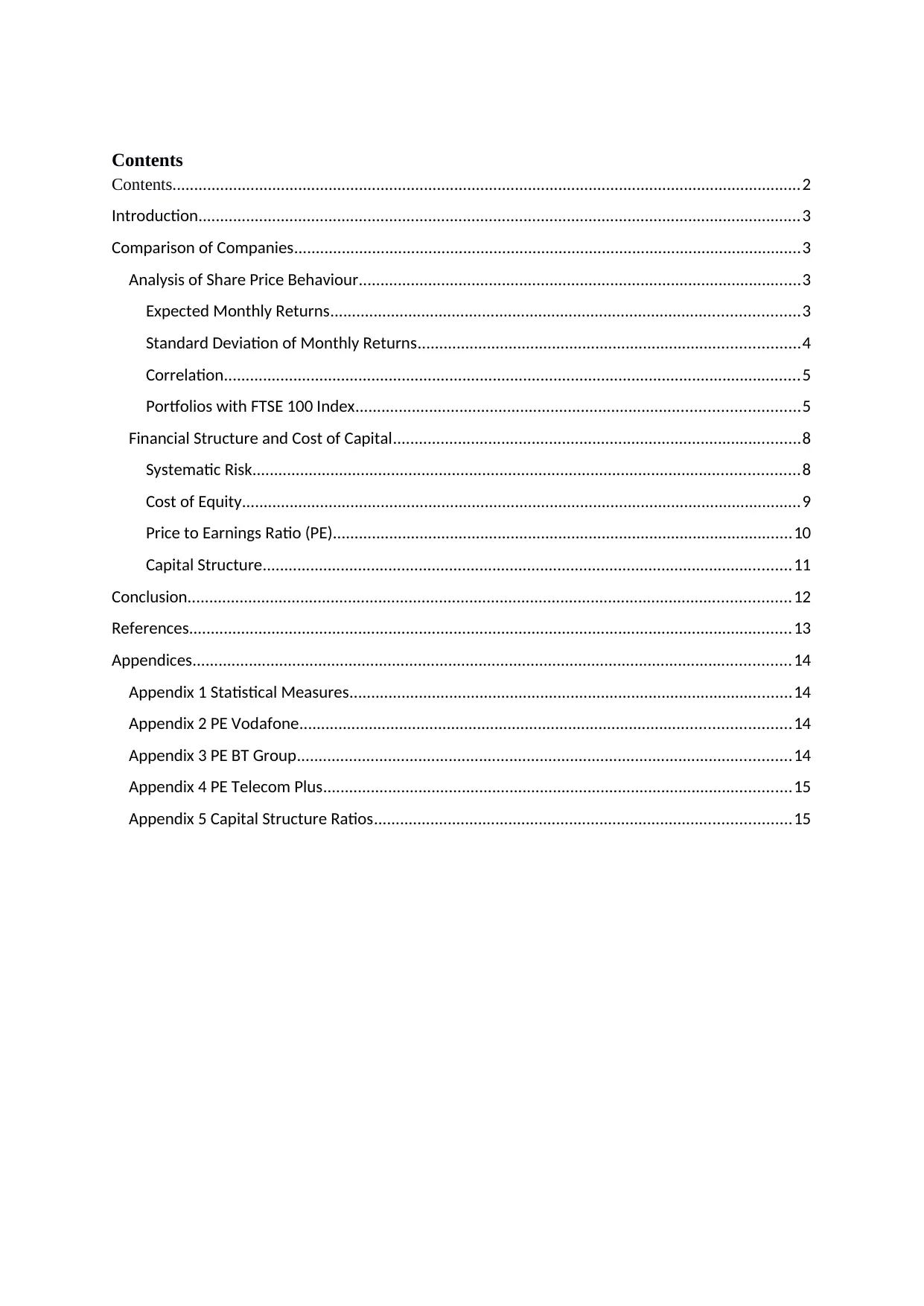
Contents
Contents.................................................................................................................................................2
Introduction...........................................................................................................................................3
Comparison of Companies.....................................................................................................................3
Analysis of Share Price Behaviour......................................................................................................3
Expected Monthly Returns............................................................................................................3
Standard Deviation of Monthly Returns........................................................................................4
Correlation.....................................................................................................................................5
Portfolios with FTSE 100 Index......................................................................................................5
Financial Structure and Cost of Capital..............................................................................................8
Systematic Risk..............................................................................................................................8
Cost of Equity.................................................................................................................................9
Price to Earnings Ratio (PE)..........................................................................................................10
Capital Structure..........................................................................................................................11
Conclusion...........................................................................................................................................12
References...........................................................................................................................................13
Appendices..........................................................................................................................................14
Appendix 1 Statistical Measures......................................................................................................14
Appendix 2 PE Vodafone.................................................................................................................14
Appendix 3 PE BT Group..................................................................................................................14
Appendix 4 PE Telecom Plus............................................................................................................15
Appendix 5 Capital Structure Ratios................................................................................................15
Contents.................................................................................................................................................2
Introduction...........................................................................................................................................3
Comparison of Companies.....................................................................................................................3
Analysis of Share Price Behaviour......................................................................................................3
Expected Monthly Returns............................................................................................................3
Standard Deviation of Monthly Returns........................................................................................4
Correlation.....................................................................................................................................5
Portfolios with FTSE 100 Index......................................................................................................5
Financial Structure and Cost of Capital..............................................................................................8
Systematic Risk..............................................................................................................................8
Cost of Equity.................................................................................................................................9
Price to Earnings Ratio (PE)..........................................................................................................10
Capital Structure..........................................................................................................................11
Conclusion...........................................................................................................................................12
References...........................................................................................................................................13
Appendices..........................................................................................................................................14
Appendix 1 Statistical Measures......................................................................................................14
Appendix 2 PE Vodafone.................................................................................................................14
Appendix 3 PE BT Group..................................................................................................................14
Appendix 4 PE Telecom Plus............................................................................................................15
Appendix 5 Capital Structure Ratios................................................................................................15
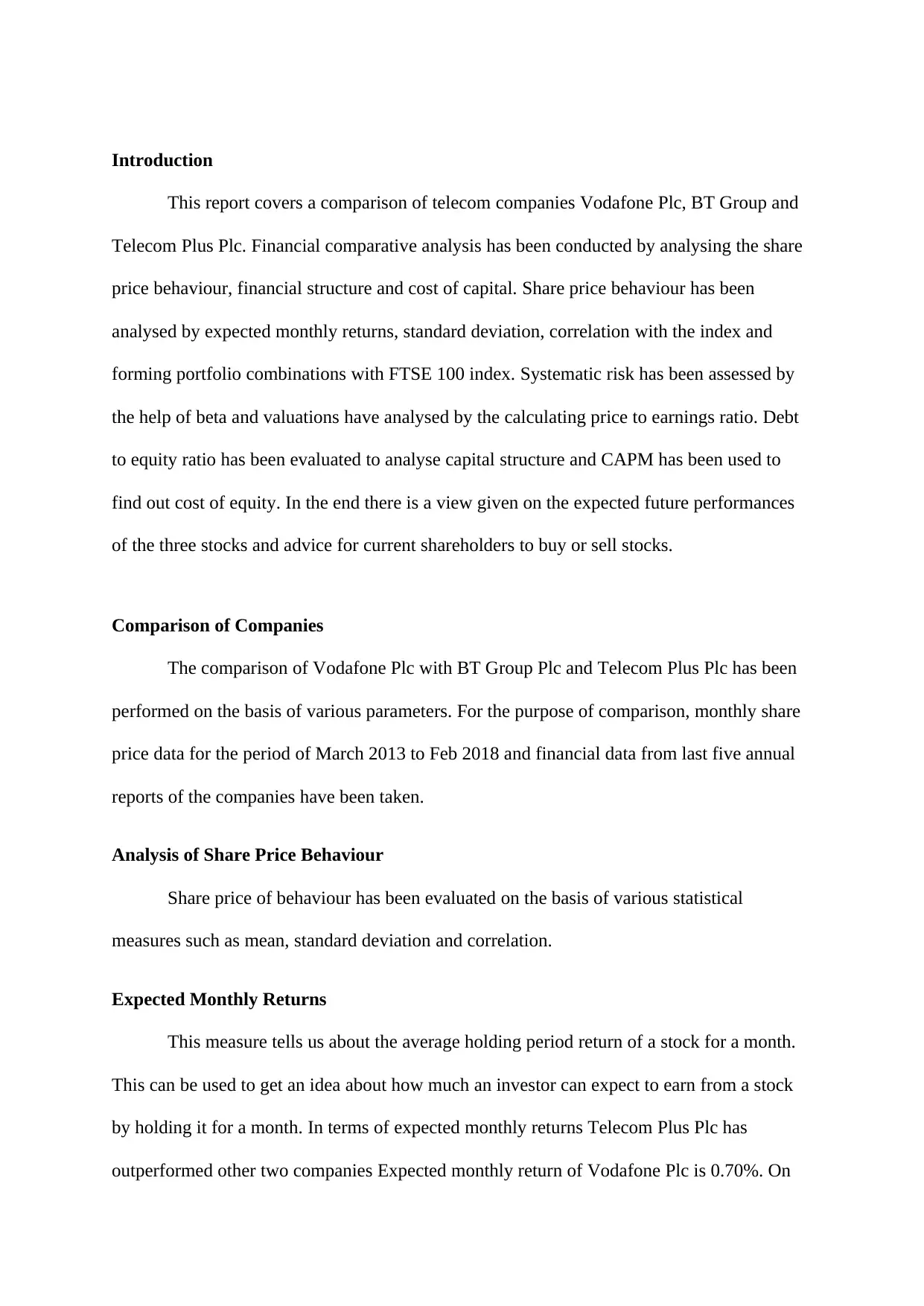
Introduction
This report covers a comparison of telecom companies Vodafone Plc, BT Group and
Telecom Plus Plc. Financial comparative analysis has been conducted by analysing the share
price behaviour, financial structure and cost of capital. Share price behaviour has been
analysed by expected monthly returns, standard deviation, correlation with the index and
forming portfolio combinations with FTSE 100 index. Systematic risk has been assessed by
the help of beta and valuations have analysed by the calculating price to earnings ratio. Debt
to equity ratio has been evaluated to analyse capital structure and CAPM has been used to
find out cost of equity. In the end there is a view given on the expected future performances
of the three stocks and advice for current shareholders to buy or sell stocks.
Comparison of Companies
The comparison of Vodafone Plc with BT Group Plc and Telecom Plus Plc has been
performed on the basis of various parameters. For the purpose of comparison, monthly share
price data for the period of March 2013 to Feb 2018 and financial data from last five annual
reports of the companies have been taken.
Analysis of Share Price Behaviour
Share price of behaviour has been evaluated on the basis of various statistical
measures such as mean, standard deviation and correlation.
Expected Monthly Returns
This measure tells us about the average holding period return of a stock for a month.
This can be used to get an idea about how much an investor can expect to earn from a stock
by holding it for a month. In terms of expected monthly returns Telecom Plus Plc has
outperformed other two companies Expected monthly return of Vodafone Plc is 0.70%. On
This report covers a comparison of telecom companies Vodafone Plc, BT Group and
Telecom Plus Plc. Financial comparative analysis has been conducted by analysing the share
price behaviour, financial structure and cost of capital. Share price behaviour has been
analysed by expected monthly returns, standard deviation, correlation with the index and
forming portfolio combinations with FTSE 100 index. Systematic risk has been assessed by
the help of beta and valuations have analysed by the calculating price to earnings ratio. Debt
to equity ratio has been evaluated to analyse capital structure and CAPM has been used to
find out cost of equity. In the end there is a view given on the expected future performances
of the three stocks and advice for current shareholders to buy or sell stocks.
Comparison of Companies
The comparison of Vodafone Plc with BT Group Plc and Telecom Plus Plc has been
performed on the basis of various parameters. For the purpose of comparison, monthly share
price data for the period of March 2013 to Feb 2018 and financial data from last five annual
reports of the companies have been taken.
Analysis of Share Price Behaviour
Share price of behaviour has been evaluated on the basis of various statistical
measures such as mean, standard deviation and correlation.
Expected Monthly Returns
This measure tells us about the average holding period return of a stock for a month.
This can be used to get an idea about how much an investor can expect to earn from a stock
by holding it for a month. In terms of expected monthly returns Telecom Plus Plc has
outperformed other two companies Expected monthly return of Vodafone Plc is 0.70%. On
⊘ This is a preview!⊘
Do you want full access?
Subscribe today to unlock all pages.

Trusted by 1+ million students worldwide
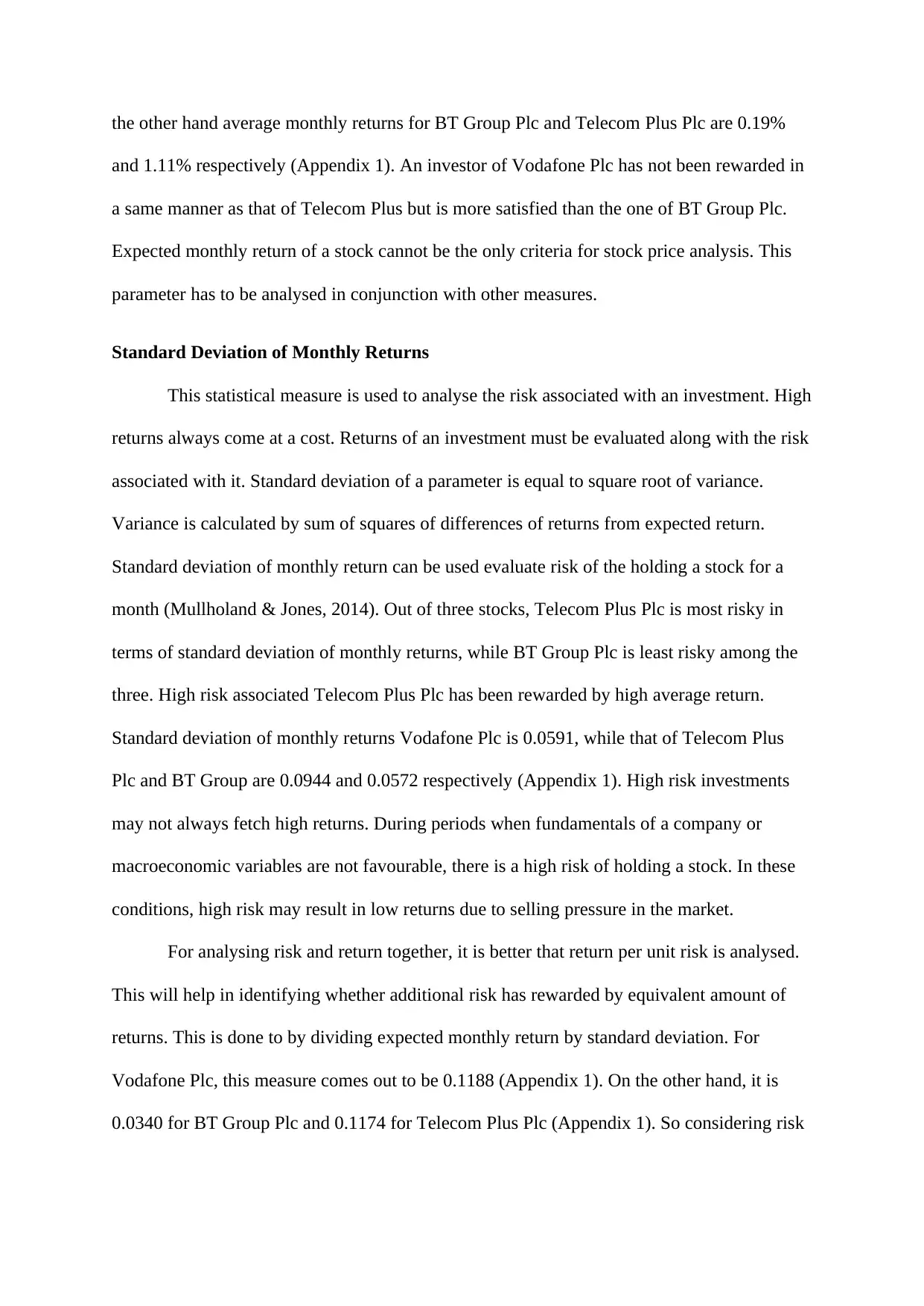
the other hand average monthly returns for BT Group Plc and Telecom Plus Plc are 0.19%
and 1.11% respectively (Appendix 1). An investor of Vodafone Plc has not been rewarded in
a same manner as that of Telecom Plus but is more satisfied than the one of BT Group Plc.
Expected monthly return of a stock cannot be the only criteria for stock price analysis. This
parameter has to be analysed in conjunction with other measures.
Standard Deviation of Monthly Returns
This statistical measure is used to analyse the risk associated with an investment. High
returns always come at a cost. Returns of an investment must be evaluated along with the risk
associated with it. Standard deviation of a parameter is equal to square root of variance.
Variance is calculated by sum of squares of differences of returns from expected return.
Standard deviation of monthly return can be used evaluate risk of the holding a stock for a
month (Mullholand & Jones, 2014). Out of three stocks, Telecom Plus Plc is most risky in
terms of standard deviation of monthly returns, while BT Group Plc is least risky among the
three. High risk associated Telecom Plus Plc has been rewarded by high average return.
Standard deviation of monthly returns Vodafone Plc is 0.0591, while that of Telecom Plus
Plc and BT Group are 0.0944 and 0.0572 respectively (Appendix 1). High risk investments
may not always fetch high returns. During periods when fundamentals of a company or
macroeconomic variables are not favourable, there is a high risk of holding a stock. In these
conditions, high risk may result in low returns due to selling pressure in the market.
For analysing risk and return together, it is better that return per unit risk is analysed.
This will help in identifying whether additional risk has rewarded by equivalent amount of
returns. This is done to by dividing expected monthly return by standard deviation. For
Vodafone Plc, this measure comes out to be 0.1188 (Appendix 1). On the other hand, it is
0.0340 for BT Group Plc and 0.1174 for Telecom Plus Plc (Appendix 1). So considering risk
and 1.11% respectively (Appendix 1). An investor of Vodafone Plc has not been rewarded in
a same manner as that of Telecom Plus but is more satisfied than the one of BT Group Plc.
Expected monthly return of a stock cannot be the only criteria for stock price analysis. This
parameter has to be analysed in conjunction with other measures.
Standard Deviation of Monthly Returns
This statistical measure is used to analyse the risk associated with an investment. High
returns always come at a cost. Returns of an investment must be evaluated along with the risk
associated with it. Standard deviation of a parameter is equal to square root of variance.
Variance is calculated by sum of squares of differences of returns from expected return.
Standard deviation of monthly return can be used evaluate risk of the holding a stock for a
month (Mullholand & Jones, 2014). Out of three stocks, Telecom Plus Plc is most risky in
terms of standard deviation of monthly returns, while BT Group Plc is least risky among the
three. High risk associated Telecom Plus Plc has been rewarded by high average return.
Standard deviation of monthly returns Vodafone Plc is 0.0591, while that of Telecom Plus
Plc and BT Group are 0.0944 and 0.0572 respectively (Appendix 1). High risk investments
may not always fetch high returns. During periods when fundamentals of a company or
macroeconomic variables are not favourable, there is a high risk of holding a stock. In these
conditions, high risk may result in low returns due to selling pressure in the market.
For analysing risk and return together, it is better that return per unit risk is analysed.
This will help in identifying whether additional risk has rewarded by equivalent amount of
returns. This is done to by dividing expected monthly return by standard deviation. For
Vodafone Plc, this measure comes out to be 0.1188 (Appendix 1). On the other hand, it is
0.0340 for BT Group Plc and 0.1174 for Telecom Plus Plc (Appendix 1). So considering risk
Paraphrase This Document
Need a fresh take? Get an instant paraphrase of this document with our AI Paraphraser
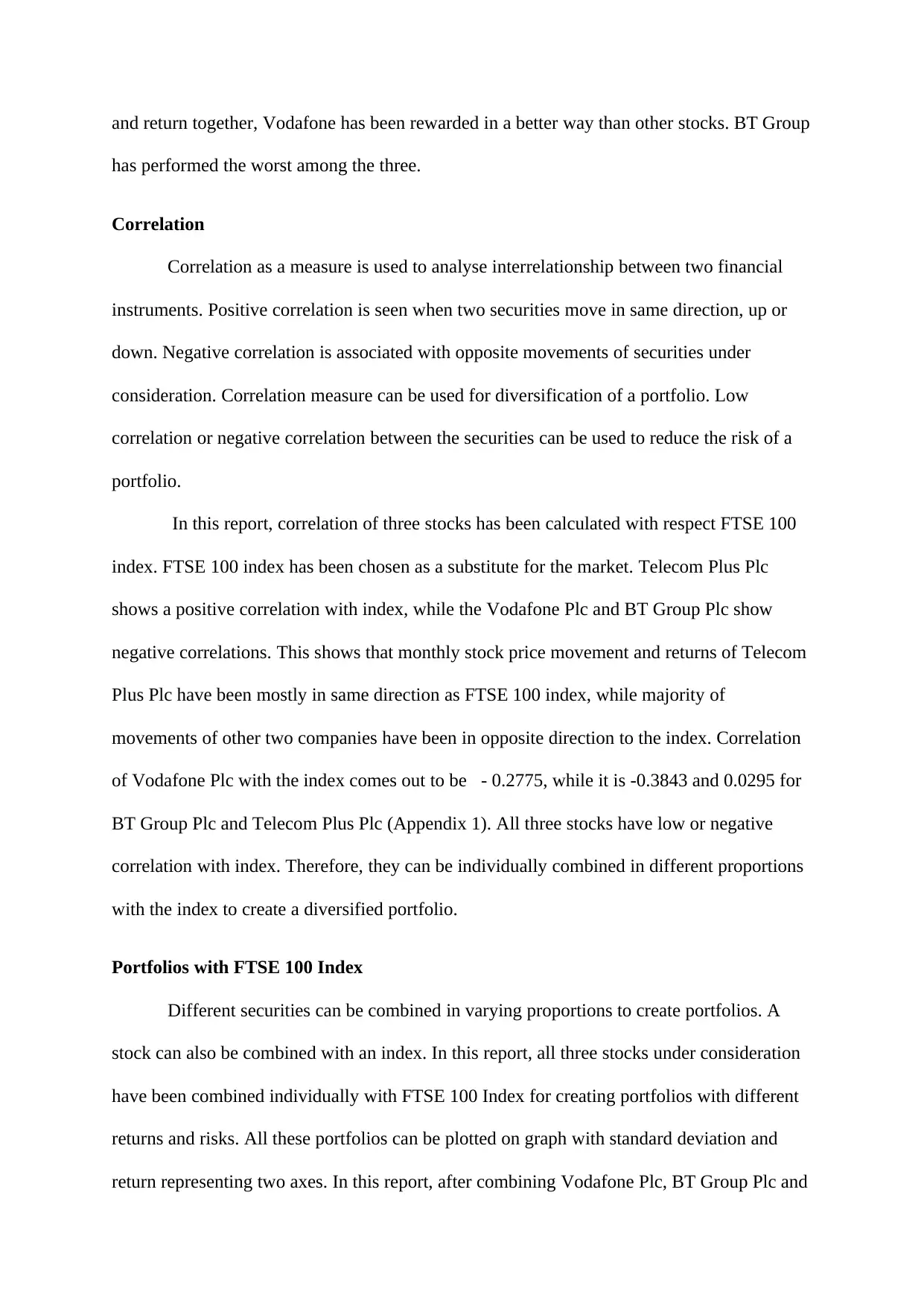
and return together, Vodafone has been rewarded in a better way than other stocks. BT Group
has performed the worst among the three.
Correlation
Correlation as a measure is used to analyse interrelationship between two financial
instruments. Positive correlation is seen when two securities move in same direction, up or
down. Negative correlation is associated with opposite movements of securities under
consideration. Correlation measure can be used for diversification of a portfolio. Low
correlation or negative correlation between the securities can be used to reduce the risk of a
portfolio.
In this report, correlation of three stocks has been calculated with respect FTSE 100
index. FTSE 100 index has been chosen as a substitute for the market. Telecom Plus Plc
shows a positive correlation with index, while the Vodafone Plc and BT Group Plc show
negative correlations. This shows that monthly stock price movement and returns of Telecom
Plus Plc have been mostly in same direction as FTSE 100 index, while majority of
movements of other two companies have been in opposite direction to the index. Correlation
of Vodafone Plc with the index comes out to be - 0.2775, while it is -0.3843 and 0.0295 for
BT Group Plc and Telecom Plus Plc (Appendix 1). All three stocks have low or negative
correlation with index. Therefore, they can be individually combined in different proportions
with the index to create a diversified portfolio.
Portfolios with FTSE 100 Index
Different securities can be combined in varying proportions to create portfolios. A
stock can also be combined with an index. In this report, all three stocks under consideration
have been combined individually with FTSE 100 Index for creating portfolios with different
returns and risks. All these portfolios can be plotted on graph with standard deviation and
return representing two axes. In this report, after combining Vodafone Plc, BT Group Plc and
has performed the worst among the three.
Correlation
Correlation as a measure is used to analyse interrelationship between two financial
instruments. Positive correlation is seen when two securities move in same direction, up or
down. Negative correlation is associated with opposite movements of securities under
consideration. Correlation measure can be used for diversification of a portfolio. Low
correlation or negative correlation between the securities can be used to reduce the risk of a
portfolio.
In this report, correlation of three stocks has been calculated with respect FTSE 100
index. FTSE 100 index has been chosen as a substitute for the market. Telecom Plus Plc
shows a positive correlation with index, while the Vodafone Plc and BT Group Plc show
negative correlations. This shows that monthly stock price movement and returns of Telecom
Plus Plc have been mostly in same direction as FTSE 100 index, while majority of
movements of other two companies have been in opposite direction to the index. Correlation
of Vodafone Plc with the index comes out to be - 0.2775, while it is -0.3843 and 0.0295 for
BT Group Plc and Telecom Plus Plc (Appendix 1). All three stocks have low or negative
correlation with index. Therefore, they can be individually combined in different proportions
with the index to create a diversified portfolio.
Portfolios with FTSE 100 Index
Different securities can be combined in varying proportions to create portfolios. A
stock can also be combined with an index. In this report, all three stocks under consideration
have been combined individually with FTSE 100 Index for creating portfolios with different
returns and risks. All these portfolios can be plotted on graph with standard deviation and
return representing two axes. In this report, after combining Vodafone Plc, BT Group Plc and
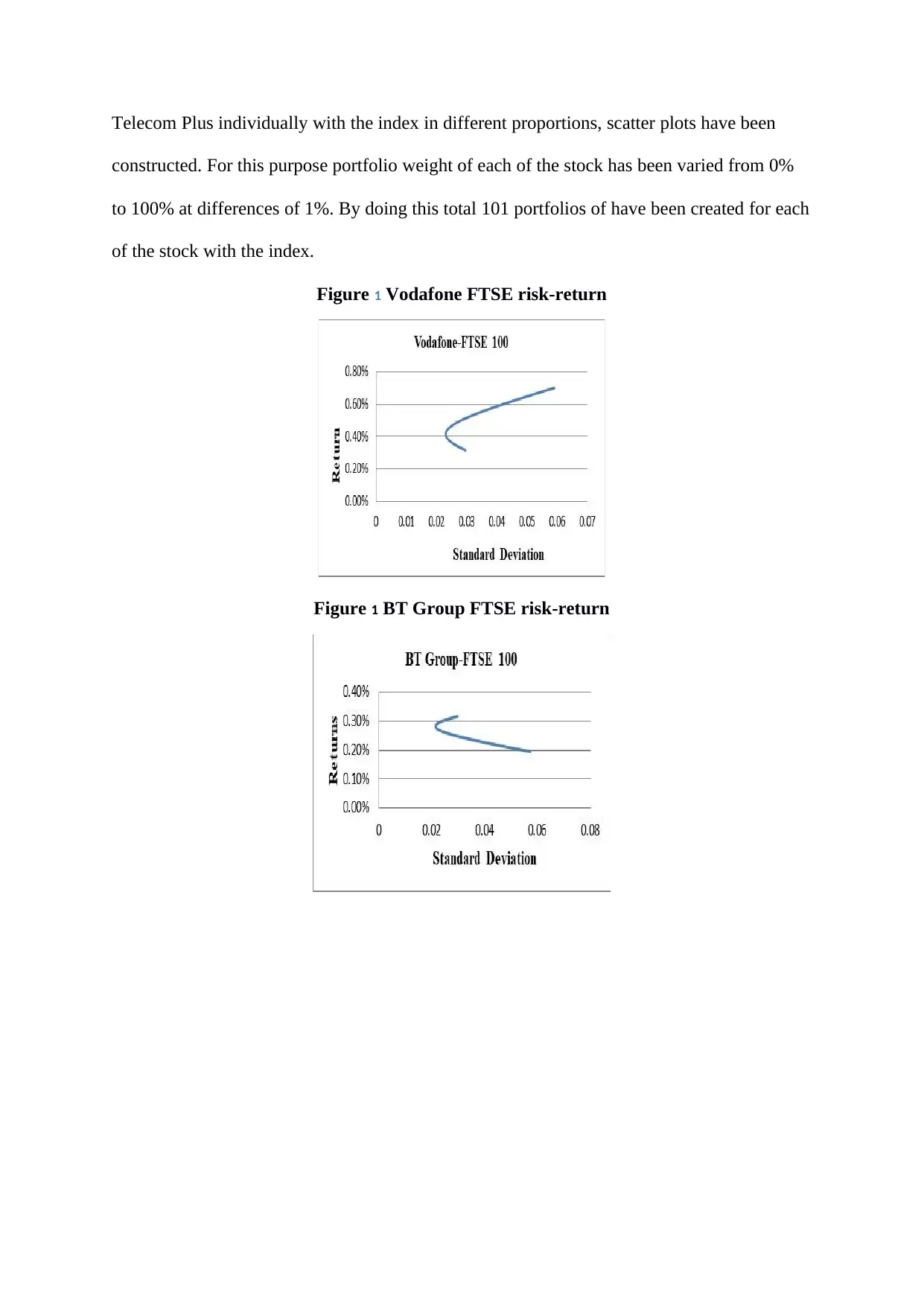
Telecom Plus individually with the index in different proportions, scatter plots have been
constructed. For this purpose portfolio weight of each of the stock has been varied from 0%
to 100% at differences of 1%. By doing this total 101 portfolios of have been created for each
of the stock with the index.
Figure 1 Vodafone FTSE risk-return
Figure 1 BT Group FTSE risk-return
constructed. For this purpose portfolio weight of each of the stock has been varied from 0%
to 100% at differences of 1%. By doing this total 101 portfolios of have been created for each
of the stock with the index.
Figure 1 Vodafone FTSE risk-return
Figure 1 BT Group FTSE risk-return
⊘ This is a preview!⊘
Do you want full access?
Subscribe today to unlock all pages.

Trusted by 1+ million students worldwide

Figure 1 Telecom Plus FTSE risk-return
After plotting the graph, a minimum variance portfolio can be found out using solver
function in excel. A minimum variance portfolio represents a portfolio, with weights of
individual securities combined in such a way that it gives minimum variance out of all the
portfolios.
Weight Vodafone Plc
Weight
FTSE 100 Portfolio Return Portfolio Variance
Portfolio
Standard
Deviation
25.53% 74.47% 0.42% 0.0005 0.0230
75
Minimum Variance Portfolio Vodafone (Using Sovler Function)
Number of Portfolio Combinations which are above Minimum Variance Portfolio
Weight BT Group Plc
Weight
FTSE
100
Portfolio
Return Portfolio Variance
Portfolio
Standard
Deviation
27.96% 72.04% 0.283% 0.0005 0.0213
28
Minimum Variance Portfolio BT Group ( Using Solver Function)
Number of Portfolio Combinations which are above Minimum Variance Portfolio
Weight Vodafone Plc
Weight
FTSE
100 Portfolio Return Portfolio Variance
Portfolio
Standard
Deviation
8.26% 91.74% 0.38% 0.0008 0.0285
92
Minimum Variance Portfolio Telecom Plus (Using Sovler Function)
Number of Portfolio Combinations which are above Minimum Variance Portfolio
After plotting the graph, a minimum variance portfolio can be found out using solver
function in excel. A minimum variance portfolio represents a portfolio, with weights of
individual securities combined in such a way that it gives minimum variance out of all the
portfolios.
Weight Vodafone Plc
Weight
FTSE 100 Portfolio Return Portfolio Variance
Portfolio
Standard
Deviation
25.53% 74.47% 0.42% 0.0005 0.0230
75
Minimum Variance Portfolio Vodafone (Using Sovler Function)
Number of Portfolio Combinations which are above Minimum Variance Portfolio
Weight BT Group Plc
Weight
FTSE
100
Portfolio
Return Portfolio Variance
Portfolio
Standard
Deviation
27.96% 72.04% 0.283% 0.0005 0.0213
28
Minimum Variance Portfolio BT Group ( Using Solver Function)
Number of Portfolio Combinations which are above Minimum Variance Portfolio
Weight Vodafone Plc
Weight
FTSE
100 Portfolio Return Portfolio Variance
Portfolio
Standard
Deviation
8.26% 91.74% 0.38% 0.0008 0.0285
92
Minimum Variance Portfolio Telecom Plus (Using Sovler Function)
Number of Portfolio Combinations which are above Minimum Variance Portfolio
Paraphrase This Document
Need a fresh take? Get an instant paraphrase of this document with our AI Paraphraser
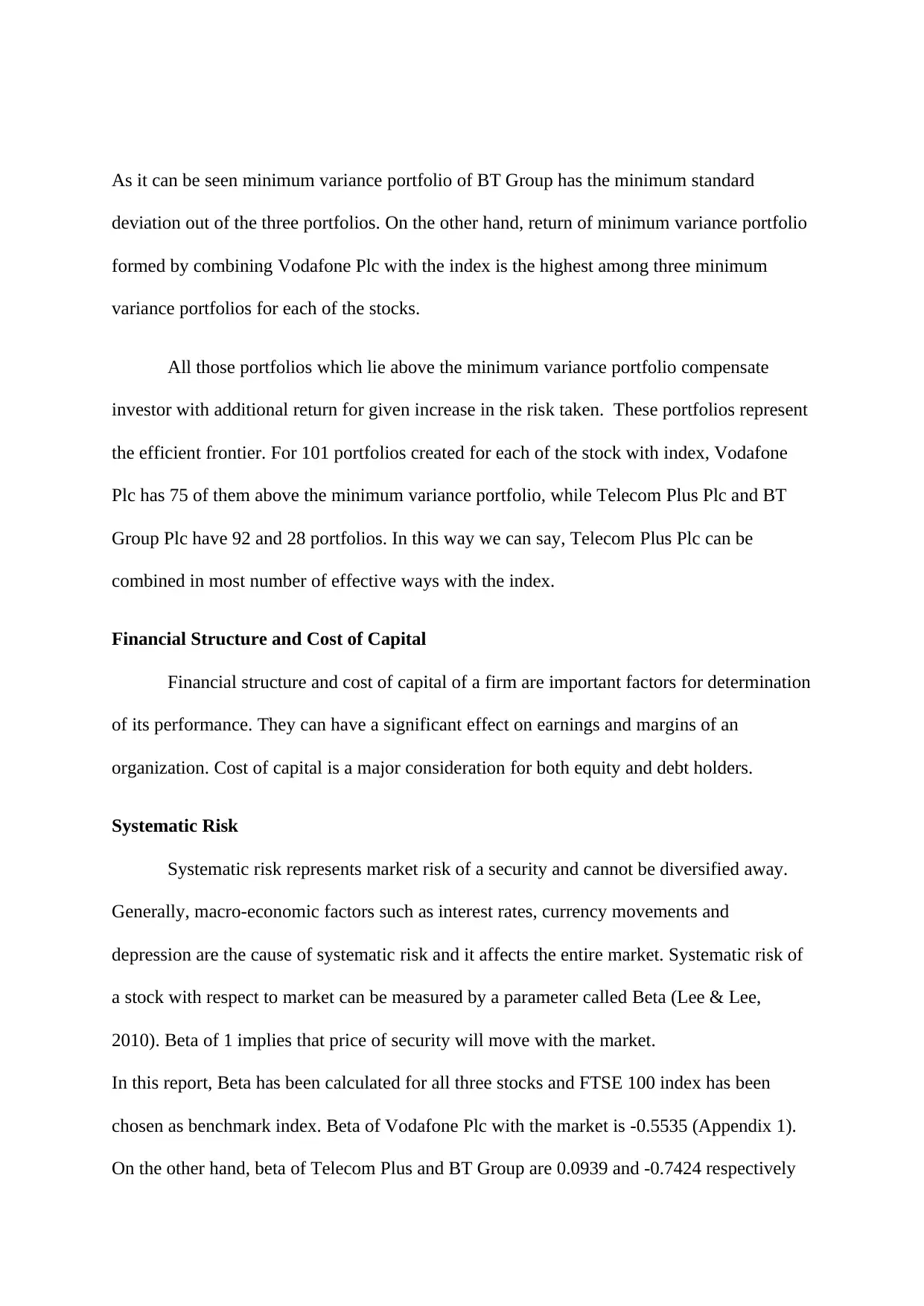
As it can be seen minimum variance portfolio of BT Group has the minimum standard
deviation out of the three portfolios. On the other hand, return of minimum variance portfolio
formed by combining Vodafone Plc with the index is the highest among three minimum
variance portfolios for each of the stocks.
All those portfolios which lie above the minimum variance portfolio compensate
investor with additional return for given increase in the risk taken. These portfolios represent
the efficient frontier. For 101 portfolios created for each of the stock with index, Vodafone
Plc has 75 of them above the minimum variance portfolio, while Telecom Plus Plc and BT
Group Plc have 92 and 28 portfolios. In this way we can say, Telecom Plus Plc can be
combined in most number of effective ways with the index.
Financial Structure and Cost of Capital
Financial structure and cost of capital of a firm are important factors for determination
of its performance. They can have a significant effect on earnings and margins of an
organization. Cost of capital is a major consideration for both equity and debt holders.
Systematic Risk
Systematic risk represents market risk of a security and cannot be diversified away.
Generally, macro-economic factors such as interest rates, currency movements and
depression are the cause of systematic risk and it affects the entire market. Systematic risk of
a stock with respect to market can be measured by a parameter called Beta (Lee & Lee,
2010). Beta of 1 implies that price of security will move with the market.
In this report, Beta has been calculated for all three stocks and FTSE 100 index has been
chosen as benchmark index. Beta of Vodafone Plc with the market is -0.5535 (Appendix 1).
On the other hand, beta of Telecom Plus and BT Group are 0.0939 and -0.7424 respectively
deviation out of the three portfolios. On the other hand, return of minimum variance portfolio
formed by combining Vodafone Plc with the index is the highest among three minimum
variance portfolios for each of the stocks.
All those portfolios which lie above the minimum variance portfolio compensate
investor with additional return for given increase in the risk taken. These portfolios represent
the efficient frontier. For 101 portfolios created for each of the stock with index, Vodafone
Plc has 75 of them above the minimum variance portfolio, while Telecom Plus Plc and BT
Group Plc have 92 and 28 portfolios. In this way we can say, Telecom Plus Plc can be
combined in most number of effective ways with the index.
Financial Structure and Cost of Capital
Financial structure and cost of capital of a firm are important factors for determination
of its performance. They can have a significant effect on earnings and margins of an
organization. Cost of capital is a major consideration for both equity and debt holders.
Systematic Risk
Systematic risk represents market risk of a security and cannot be diversified away.
Generally, macro-economic factors such as interest rates, currency movements and
depression are the cause of systematic risk and it affects the entire market. Systematic risk of
a stock with respect to market can be measured by a parameter called Beta (Lee & Lee,
2010). Beta of 1 implies that price of security will move with the market.
In this report, Beta has been calculated for all three stocks and FTSE 100 index has been
chosen as benchmark index. Beta of Vodafone Plc with the market is -0.5535 (Appendix 1).
On the other hand, beta of Telecom Plus and BT Group are 0.0939 and -0.7424 respectively
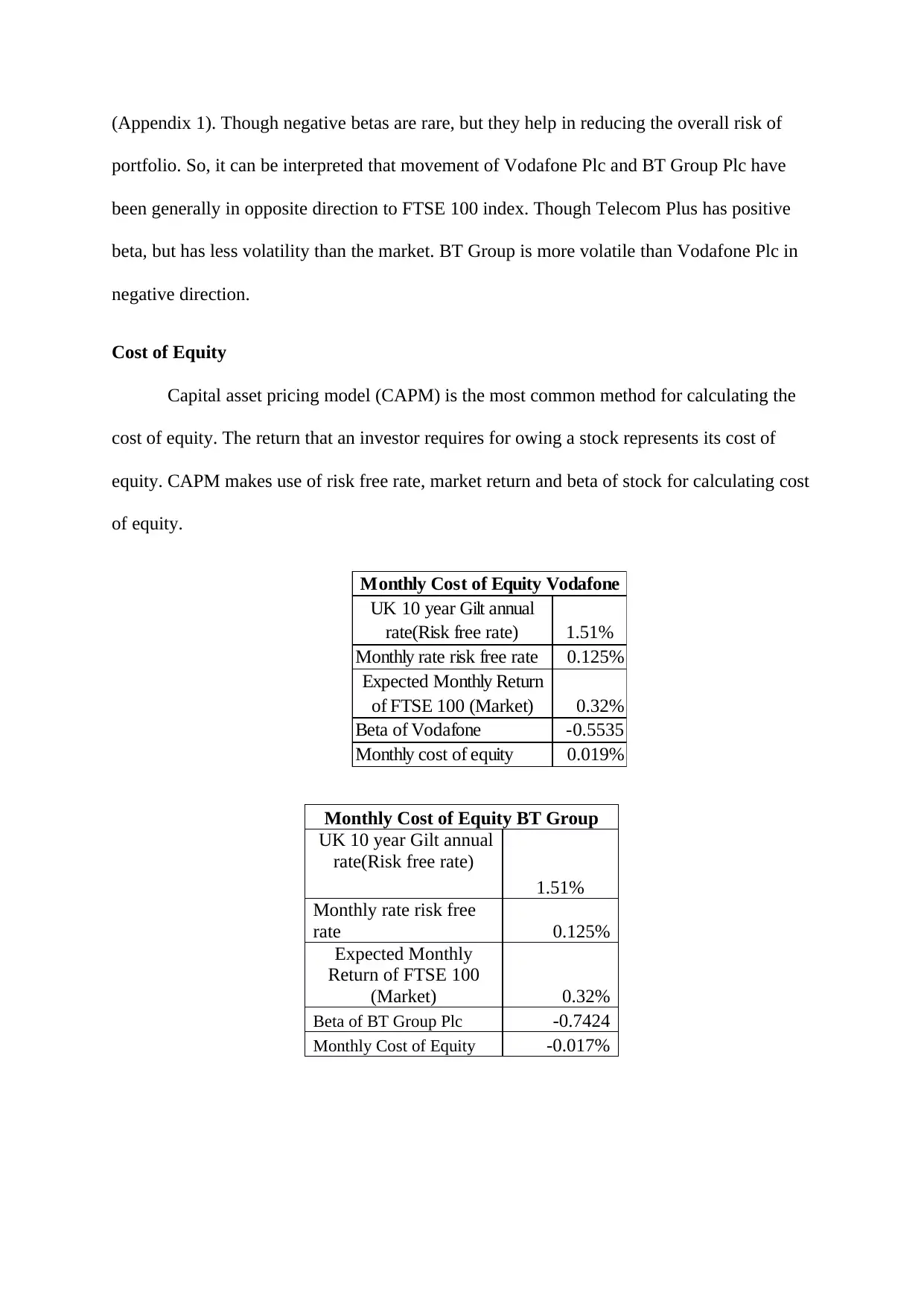
(Appendix 1). Though negative betas are rare, but they help in reducing the overall risk of
portfolio. So, it can be interpreted that movement of Vodafone Plc and BT Group Plc have
been generally in opposite direction to FTSE 100 index. Though Telecom Plus has positive
beta, but has less volatility than the market. BT Group is more volatile than Vodafone Plc in
negative direction.
Cost of Equity
Capital asset pricing model (CAPM) is the most common method for calculating the
cost of equity. The return that an investor requires for owing a stock represents its cost of
equity. CAPM makes use of risk free rate, market return and beta of stock for calculating cost
of equity.
Monthly rate risk free rate 0.125%
Beta of Vodafone -0.5535
Monthly cost of equity 0.019%
UK 10 year Gilt annual
rate(Risk free rate) 1.51%
Expected Monthly Return
of FTSE 100 (Market) 0.32%
Monthly Cost of Equity Vodafone
Monthly Cost of Equity BT Group
UK 10 year Gilt annual
rate(Risk free rate)
1.51%
Monthly rate risk free
rate 0.125%
Expected Monthly
Return of FTSE 100
(Market) 0.32%
Beta of BT Group Plc -0.7424
Monthly Cost of Equity -0.017%
portfolio. So, it can be interpreted that movement of Vodafone Plc and BT Group Plc have
been generally in opposite direction to FTSE 100 index. Though Telecom Plus has positive
beta, but has less volatility than the market. BT Group is more volatile than Vodafone Plc in
negative direction.
Cost of Equity
Capital asset pricing model (CAPM) is the most common method for calculating the
cost of equity. The return that an investor requires for owing a stock represents its cost of
equity. CAPM makes use of risk free rate, market return and beta of stock for calculating cost
of equity.
Monthly rate risk free rate 0.125%
Beta of Vodafone -0.5535
Monthly cost of equity 0.019%
UK 10 year Gilt annual
rate(Risk free rate) 1.51%
Expected Monthly Return
of FTSE 100 (Market) 0.32%
Monthly Cost of Equity Vodafone
Monthly Cost of Equity BT Group
UK 10 year Gilt annual
rate(Risk free rate)
1.51%
Monthly rate risk free
rate 0.125%
Expected Monthly
Return of FTSE 100
(Market) 0.32%
Beta of BT Group Plc -0.7424
Monthly Cost of Equity -0.017%
⊘ This is a preview!⊘
Do you want full access?
Subscribe today to unlock all pages.

Trusted by 1+ million students worldwide
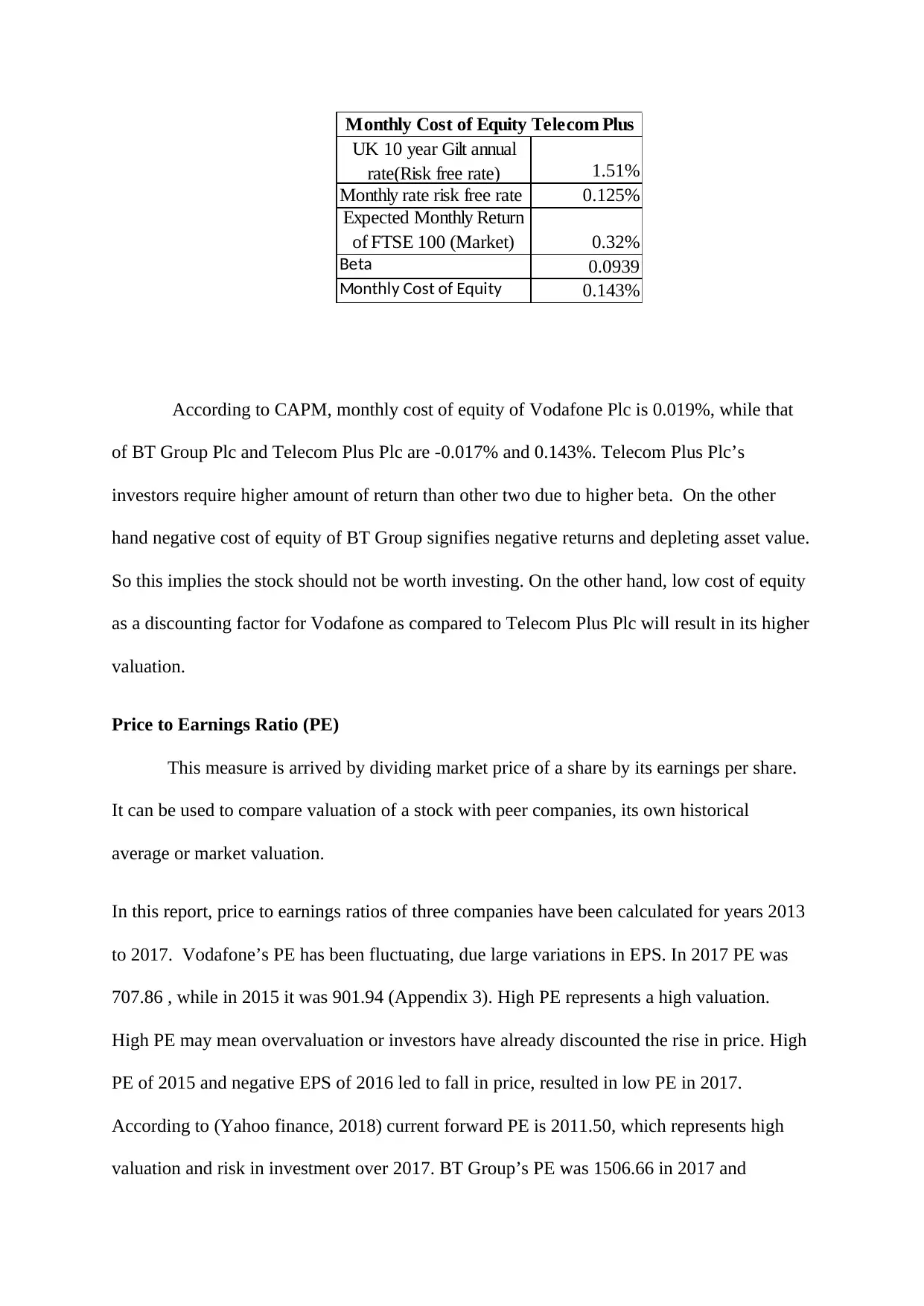
Monthly rate risk free rate 0.125%
Beta 0.0939
Monthly Cost of Equity 0.143%
UK 10 year Gilt annual
rate(Risk free rate) 1.51%
Expected Monthly Return
of FTSE 100 (Market) 0.32%
Monthly Cost of Equity Telecom Plus
According to CAPM, monthly cost of equity of Vodafone Plc is 0.019%, while that
of BT Group Plc and Telecom Plus Plc are -0.017% and 0.143%. Telecom Plus Plc’s
investors require higher amount of return than other two due to higher beta. On the other
hand negative cost of equity of BT Group signifies negative returns and depleting asset value.
So this implies the stock should not be worth investing. On the other hand, low cost of equity
as a discounting factor for Vodafone as compared to Telecom Plus Plc will result in its higher
valuation.
Price to Earnings Ratio (PE)
This measure is arrived by dividing market price of a share by its earnings per share.
It can be used to compare valuation of a stock with peer companies, its own historical
average or market valuation.
In this report, price to earnings ratios of three companies have been calculated for years 2013
to 2017. Vodafone’s PE has been fluctuating, due large variations in EPS. In 2017 PE was
707.86 , while in 2015 it was 901.94 (Appendix 3). High PE represents a high valuation.
High PE may mean overvaluation or investors have already discounted the rise in price. High
PE of 2015 and negative EPS of 2016 led to fall in price, resulted in low PE in 2017.
According to (Yahoo finance, 2018) current forward PE is 2011.50, which represents high
valuation and risk in investment over 2017. BT Group’s PE was 1506.66 in 2017 and
Beta 0.0939
Monthly Cost of Equity 0.143%
UK 10 year Gilt annual
rate(Risk free rate) 1.51%
Expected Monthly Return
of FTSE 100 (Market) 0.32%
Monthly Cost of Equity Telecom Plus
According to CAPM, monthly cost of equity of Vodafone Plc is 0.019%, while that
of BT Group Plc and Telecom Plus Plc are -0.017% and 0.143%. Telecom Plus Plc’s
investors require higher amount of return than other two due to higher beta. On the other
hand negative cost of equity of BT Group signifies negative returns and depleting asset value.
So this implies the stock should not be worth investing. On the other hand, low cost of equity
as a discounting factor for Vodafone as compared to Telecom Plus Plc will result in its higher
valuation.
Price to Earnings Ratio (PE)
This measure is arrived by dividing market price of a share by its earnings per share.
It can be used to compare valuation of a stock with peer companies, its own historical
average or market valuation.
In this report, price to earnings ratios of three companies have been calculated for years 2013
to 2017. Vodafone’s PE has been fluctuating, due large variations in EPS. In 2017 PE was
707.86 , while in 2015 it was 901.94 (Appendix 3). High PE represents a high valuation.
High PE may mean overvaluation or investors have already discounted the rise in price. High
PE of 2015 and negative EPS of 2016 led to fall in price, resulted in low PE in 2017.
According to (Yahoo finance, 2018) current forward PE is 2011.50, which represents high
valuation and risk in investment over 2017. BT Group’s PE was 1506.66 in 2017 and
Paraphrase This Document
Need a fresh take? Get an instant paraphrase of this document with our AI Paraphraser
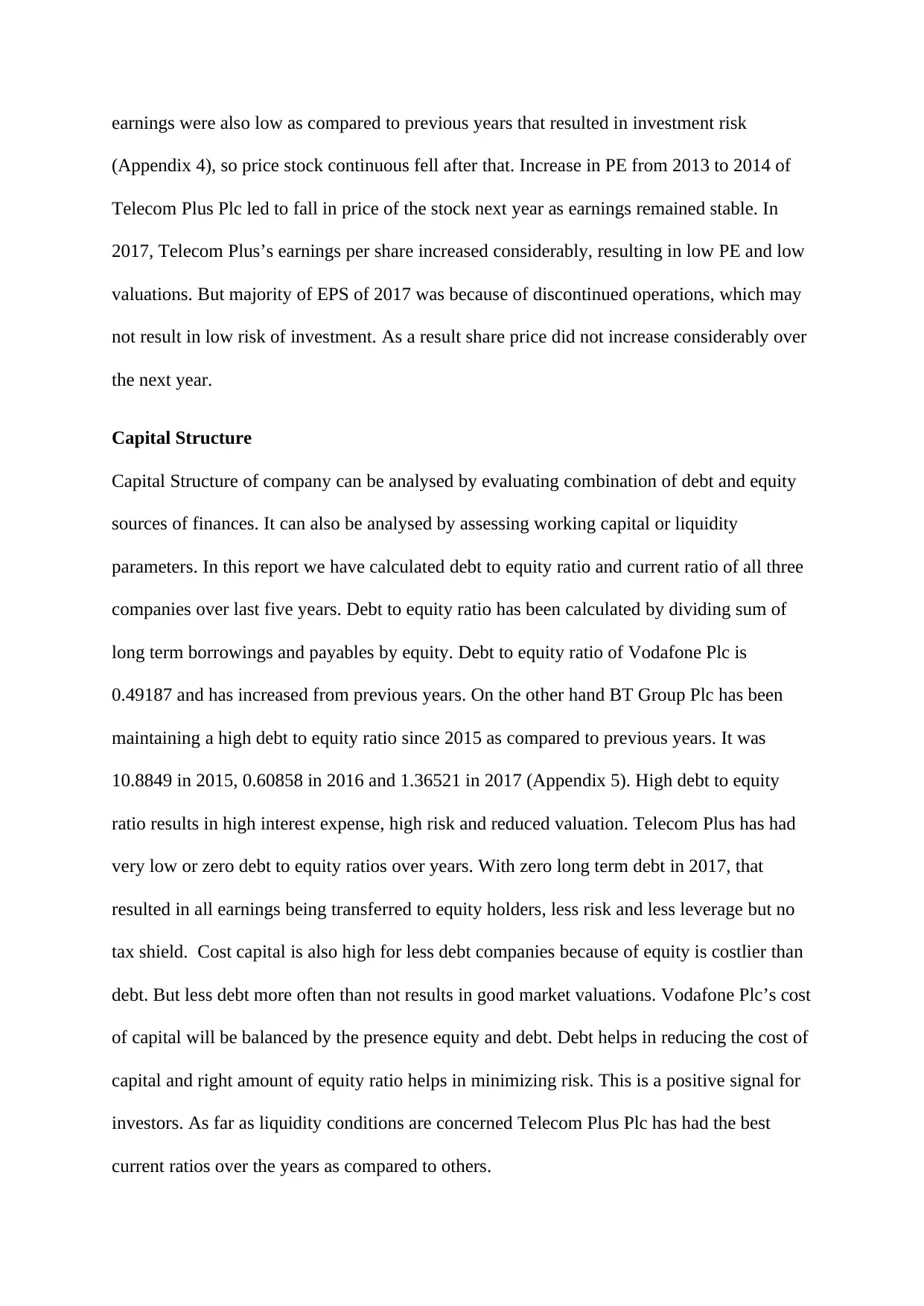
earnings were also low as compared to previous years that resulted in investment risk
(Appendix 4), so price stock continuous fell after that. Increase in PE from 2013 to 2014 of
Telecom Plus Plc led to fall in price of the stock next year as earnings remained stable. In
2017, Telecom Plus’s earnings per share increased considerably, resulting in low PE and low
valuations. But majority of EPS of 2017 was because of discontinued operations, which may
not result in low risk of investment. As a result share price did not increase considerably over
the next year.
Capital Structure
Capital Structure of company can be analysed by evaluating combination of debt and equity
sources of finances. It can also be analysed by assessing working capital or liquidity
parameters. In this report we have calculated debt to equity ratio and current ratio of all three
companies over last five years. Debt to equity ratio has been calculated by dividing sum of
long term borrowings and payables by equity. Debt to equity ratio of Vodafone Plc is
0.49187 and has increased from previous years. On the other hand BT Group Plc has been
maintaining a high debt to equity ratio since 2015 as compared to previous years. It was
10.8849 in 2015, 0.60858 in 2016 and 1.36521 in 2017 (Appendix 5). High debt to equity
ratio results in high interest expense, high risk and reduced valuation. Telecom Plus has had
very low or zero debt to equity ratios over years. With zero long term debt in 2017, that
resulted in all earnings being transferred to equity holders, less risk and less leverage but no
tax shield. Cost capital is also high for less debt companies because of equity is costlier than
debt. But less debt more often than not results in good market valuations. Vodafone Plc’s cost
of capital will be balanced by the presence equity and debt. Debt helps in reducing the cost of
capital and right amount of equity ratio helps in minimizing risk. This is a positive signal for
investors. As far as liquidity conditions are concerned Telecom Plus Plc has had the best
current ratios over the years as compared to others.
(Appendix 4), so price stock continuous fell after that. Increase in PE from 2013 to 2014 of
Telecom Plus Plc led to fall in price of the stock next year as earnings remained stable. In
2017, Telecom Plus’s earnings per share increased considerably, resulting in low PE and low
valuations. But majority of EPS of 2017 was because of discontinued operations, which may
not result in low risk of investment. As a result share price did not increase considerably over
the next year.
Capital Structure
Capital Structure of company can be analysed by evaluating combination of debt and equity
sources of finances. It can also be analysed by assessing working capital or liquidity
parameters. In this report we have calculated debt to equity ratio and current ratio of all three
companies over last five years. Debt to equity ratio has been calculated by dividing sum of
long term borrowings and payables by equity. Debt to equity ratio of Vodafone Plc is
0.49187 and has increased from previous years. On the other hand BT Group Plc has been
maintaining a high debt to equity ratio since 2015 as compared to previous years. It was
10.8849 in 2015, 0.60858 in 2016 and 1.36521 in 2017 (Appendix 5). High debt to equity
ratio results in high interest expense, high risk and reduced valuation. Telecom Plus has had
very low or zero debt to equity ratios over years. With zero long term debt in 2017, that
resulted in all earnings being transferred to equity holders, less risk and less leverage but no
tax shield. Cost capital is also high for less debt companies because of equity is costlier than
debt. But less debt more often than not results in good market valuations. Vodafone Plc’s cost
of capital will be balanced by the presence equity and debt. Debt helps in reducing the cost of
capital and right amount of equity ratio helps in minimizing risk. This is a positive signal for
investors. As far as liquidity conditions are concerned Telecom Plus Plc has had the best
current ratios over the years as compared to others.
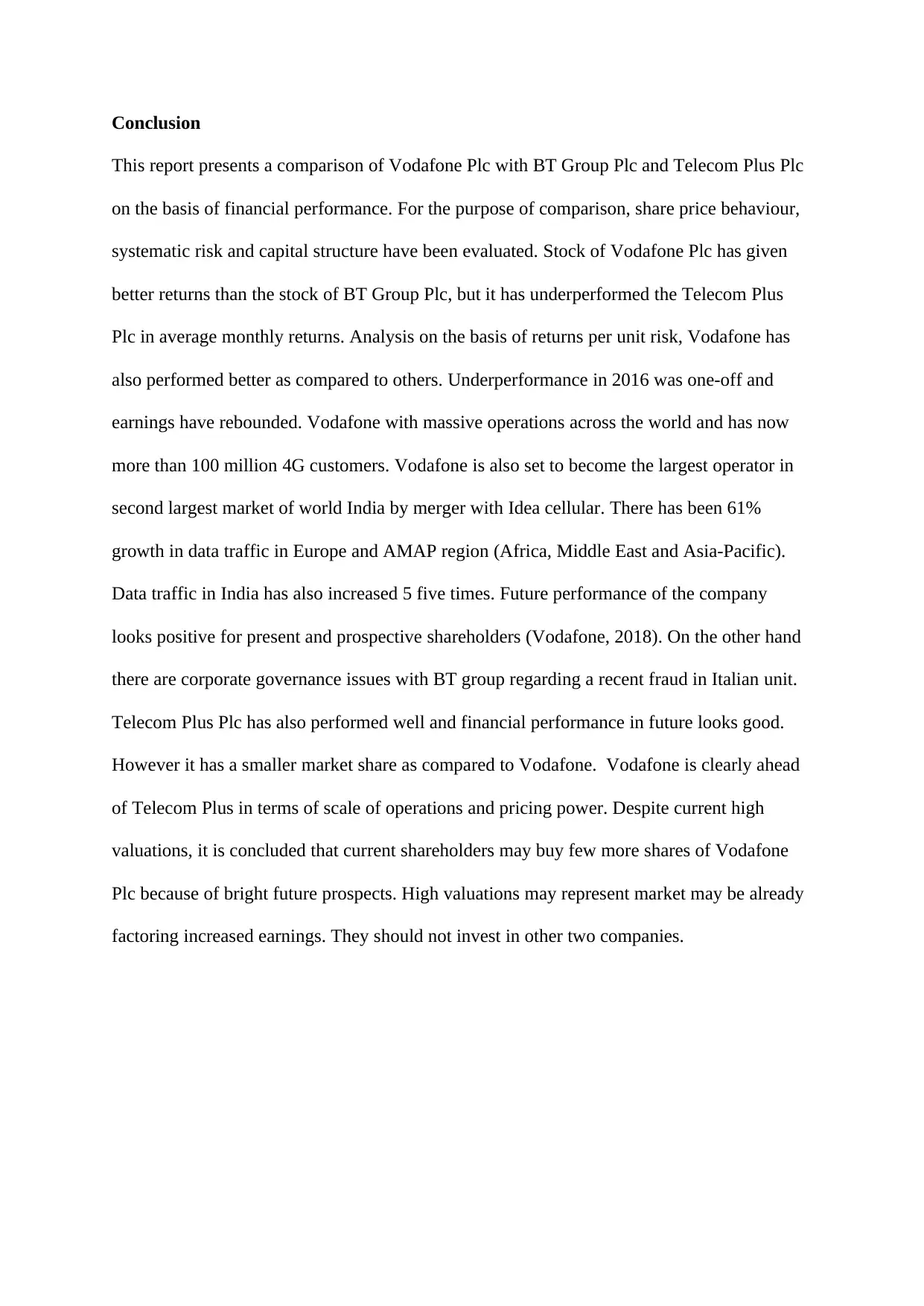
Conclusion
This report presents a comparison of Vodafone Plc with BT Group Plc and Telecom Plus Plc
on the basis of financial performance. For the purpose of comparison, share price behaviour,
systematic risk and capital structure have been evaluated. Stock of Vodafone Plc has given
better returns than the stock of BT Group Plc, but it has underperformed the Telecom Plus
Plc in average monthly returns. Analysis on the basis of returns per unit risk, Vodafone has
also performed better as compared to others. Underperformance in 2016 was one-off and
earnings have rebounded. Vodafone with massive operations across the world and has now
more than 100 million 4G customers. Vodafone is also set to become the largest operator in
second largest market of world India by merger with Idea cellular. There has been 61%
growth in data traffic in Europe and AMAP region (Africa, Middle East and Asia-Pacific).
Data traffic in India has also increased 5 five times. Future performance of the company
looks positive for present and prospective shareholders (Vodafone, 2018). On the other hand
there are corporate governance issues with BT group regarding a recent fraud in Italian unit.
Telecom Plus Plc has also performed well and financial performance in future looks good.
However it has a smaller market share as compared to Vodafone. Vodafone is clearly ahead
of Telecom Plus in terms of scale of operations and pricing power. Despite current high
valuations, it is concluded that current shareholders may buy few more shares of Vodafone
Plc because of bright future prospects. High valuations may represent market may be already
factoring increased earnings. They should not invest in other two companies.
This report presents a comparison of Vodafone Plc with BT Group Plc and Telecom Plus Plc
on the basis of financial performance. For the purpose of comparison, share price behaviour,
systematic risk and capital structure have been evaluated. Stock of Vodafone Plc has given
better returns than the stock of BT Group Plc, but it has underperformed the Telecom Plus
Plc in average monthly returns. Analysis on the basis of returns per unit risk, Vodafone has
also performed better as compared to others. Underperformance in 2016 was one-off and
earnings have rebounded. Vodafone with massive operations across the world and has now
more than 100 million 4G customers. Vodafone is also set to become the largest operator in
second largest market of world India by merger with Idea cellular. There has been 61%
growth in data traffic in Europe and AMAP region (Africa, Middle East and Asia-Pacific).
Data traffic in India has also increased 5 five times. Future performance of the company
looks positive for present and prospective shareholders (Vodafone, 2018). On the other hand
there are corporate governance issues with BT group regarding a recent fraud in Italian unit.
Telecom Plus Plc has also performed well and financial performance in future looks good.
However it has a smaller market share as compared to Vodafone. Vodafone is clearly ahead
of Telecom Plus in terms of scale of operations and pricing power. Despite current high
valuations, it is concluded that current shareholders may buy few more shares of Vodafone
Plc because of bright future prospects. High valuations may represent market may be already
factoring increased earnings. They should not invest in other two companies.
⊘ This is a preview!⊘
Do you want full access?
Subscribe today to unlock all pages.

Trusted by 1+ million students worldwide
1 out of 15